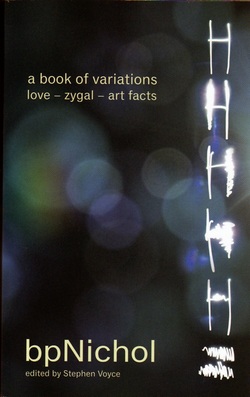
These were collections of what were for Nichol his ‘occasional poems’ – hand-drawn visual poems, typewriter poems, pataphysical poems of his “Probable Systems” series, experiments with the comic strip panel. They were poems he could complete, file away or publish without involving himself in a long-term project. Toward the end of his life he is reported to have been filing such work under two more titles: “ox, house, camel, door: a book of higher glyphs” and “truth: a book of fictions.” The new titles extended the wordplay of the three earlier ones. A collection titled Truth: a Book of Fictions, edited by Irene Niechoda, was posthumously published in 1993 by Mercury Press and is still in print.
Voyce writes that there is archival evidence that Niechoda cannibalized the manuscript of “ox, house, camel, door” in order to help give the more arrestingly titled “Truth” the length needed by the publisher. That’s quite possible, but in any case Voyce knows that this kind of collection was in Nichol’s mind an irregularly continuing series, with each volume to be published by a different publisher (10). Had Nichol lived longer there likely would have been more than
Voyce outlines the curious calendar history of the four published books but gives little explanation of how this history came about. Love was written in 1970-71 and published by Talonbooks in 1974; Zygal was written in 1971-72 and published by Coach House in 1985; Art Facts was written mostly during the late 1960s and early 1970s, placed with Chax Press in Tuscon by Nichol in 1988 and published in 1990. Most of the texts in these volumes seem to have been written during the 1967-82 period when Nichol was working as a lay psychoanalyst and was vice-president of Therafields. This was a period in which he could devote short blocks of time to stand-alone drawings or texts and give the relatively scarce longer periods of open time to long-term projects such as The Martyrology or his novels. After 1982 when he began supporting himself through writing for commercial television, he had more demands on his time but also more control over how his time was allocated. He appears to have allowed the commercial work to encroach more on his occasional writing than on The Martyrology or on his new collaborations with musicians.
Voyce suggests that “economic setbacks” delayed the publication of both Zygal and Art Facts. But the initial, and perhaps primary, cause of delay for Zygal arose from the acquisition by Coach House Press in 1973 of a computer-driven phototypesetting machine which relied for its operation on translucent – and changeable – films of letterforms in different fonts. Nichol, ever imaginative, had seen almost instantly that a font of his own handwriting might be substitutable for the films of standard fonts that had come with the machine –and that the machine thus could be adapted to typeset all of the numerous textual poems of Zygal in the author’s hand. For him this was such an irresistibly ironic possibility – to ‘machine’ a part of his creative self – that he was for several years reluctant to abandon it. The press began working on the ‘Nichol’ font, but the mathematical precision to make it workable was, as I understand it, daunting, and paying to have the font created by specialists prohibitively expensive. Eventually, the press moved to a newer generation of typesetting equipment that stored fonts in memory rather than on film, and Nichol had to resign himself to a more pedestrian production. This is probably an episode that I should have included in my biography of Nichol, whose title – aka bpNichol – would have been a great name for that never-realized font.
In his introduction Voyce also steps needlessly into the long simmering dispute among Nichol scholars about whether he is more notably the author of The Martyrology or the creator of sound poems, visual poems, and dadaistic/pataphysical texts such as those collected here (see aka bpNichol 290-91). One gathers that Voyce has undertaken this Book of Variations project in part to reinforce the claims of those who support the second view. He writes that Nichol’s non-Martyrology creations have led “recent critics” to challenge The Martyrology’s “hagiographic status at the expense of his more innovative work” (14-15, my italics). I’m not sure that the work in A Book of Variations is the “more innovative.” It may be more radical page by page, but it is less risk-taking than The Martyrology overall. Curiously, Voyce is able to make his pataphysical texts also yield hagiography, writing that such texts that Nichol wrote “‘from a research point of view’” were “for Nichol ... inexorably linked to community building” (13), that Nichol saw the poet-experimenter as “producing materials, methods, and texts for a community of others who are free to transform and adapt them” (14), and that those who assisted in creating the present volume have exhibited “the kind of open source community, camaradie and friendship that bpNichol actively fostered.” Hmmm ... I think either the pataphysical or martyrological bpNichol would have been able to find a synonym for ‘community.’
A Book of Variations is attractively produced in similar greytones and dimensions to those of Coach House’s bpNichol reader The Alphabet Game. The similarities suggest that there may some day be a Coach House standard edition Nichol – ironically echoing perhaps the “standard edition” Freud, and including a single-volume The Martyrology.
FD
 RSS Feed
RSS Feed